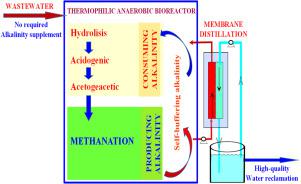Environmental Technology & Innovation ( IF 6.7 ) Pub Date : 2020-08-03 , DOI: 10.1016/j.eti.2020.101077 Chinh Cong Duong , Shiao-Shing Chen , Huy Quang Le , Hau-Ming Chang , Nguyen Cong Nguyen , Dan Thanh Ngoc Cao

|
The stability of an anaerobic bioreactor is a function of alkalinity that provides buffer capacity to maintain a suitable pH for anaerobic microorganisms. The greatest advantage of membrane distillation (MD) is the high rejection of most solutes, including alkaline salt, and it has a high potential to retain alkalinity for the anaerobic system. For the first time, a thermophilic anaerobic granular bioreactor integrated with an MD membrane to maintain the buffered pH was studied in an anaerobic bioreactor without alkalinity supplement. This study presented a comparison between a conventional thermophilic anaerobic bioreactor (TAn1) and a thermophilic anaerobic bioreactor integrated with a MD (TAn2-MD). The two TAns (TAn1 and TAn2) were operated in the same conditions except there was no alkalinity feeding for the TAn2-MD. The results showed that the pH in the TAn2-MD unit was always higher than 6.8 with the organic loading rates from 6 to 18 kg COD/m3/day. However, to maintain the pH of the TAn1 unit at the same level as the TAn2-MD unit, the minimum alkalinity requirements for TAn1 were 1.5, 1.56, 1.62, and 1.8 g/L as CaCO3 at an organic loading rate of 6, 10, 14, and 18 kg COD/m3/day, respectively. Although there was no alkalinity supplement for the TAn2-MD system, two stability indexes, FOS/TAC (volatile organic acids to buffer capacity) and IA/PA (intermediate alkalinity to partial alkalinity), indicated the system was operated at a stable condition. In summary, the designed TAn2-MD can accomplish high-efficiency organic carbon removal (higher than 99.4%) without alkalinity supplement, achieve zero-liquid-discharge, and reclaim high-quality wastewater in one step.
中文翻译:

一种新型的基于自缓冲膜蒸馏的嗜热厌氧生物反应器
厌氧生物反应器的稳定性是碱度的函数,碱度提供缓冲能力以维持适合厌氧微生物的pH。膜蒸馏(MD)的最大优势是对大多数溶质(包括碱性盐)的高排斥,并且对于厌氧系统具有很高的保留碱度的潜力。首次在不添加碱度的厌氧生物反应器中研究了与MD膜集成以维持缓冲pH值的嗜热厌氧颗粒生物反应器。这项研究提出了传统的嗜热厌氧生物反应器(TAn1)和集成了MD(TAn2-MD)的嗜热厌氧生物反应器之间的比较。两个TAn(TAn1和TAn2)在相同条件下运行,除了TAn2-MD没有碱度进料。3 /天。但是,为了将TAn1单元的pH维持在与TAn2-MD单元相同的水平,在有机负载率为6时,TAn1的最低碱度要求为CaCO 3的1.5、1.56、1.62和1.8 g / L。分别为10、14和18千克COD / m 3 /天。尽管没有为TAn2-MD系统添加碱度,但两个稳定性指标FOS / TAC(挥发性有机酸至缓冲容量)和IA / PA(中等碱度至部分碱度)表明系统在稳定条件下运行。综上所述,设计的TAn2-MD无需碱化即可实现高效有机碳去除(高于99.4%),实现零液体排放,并一步一步回收优质废水。











































 京公网安备 11010802027423号
京公网安备 11010802027423号